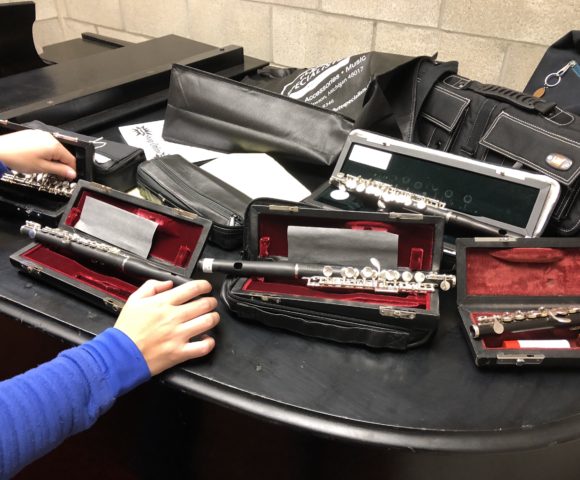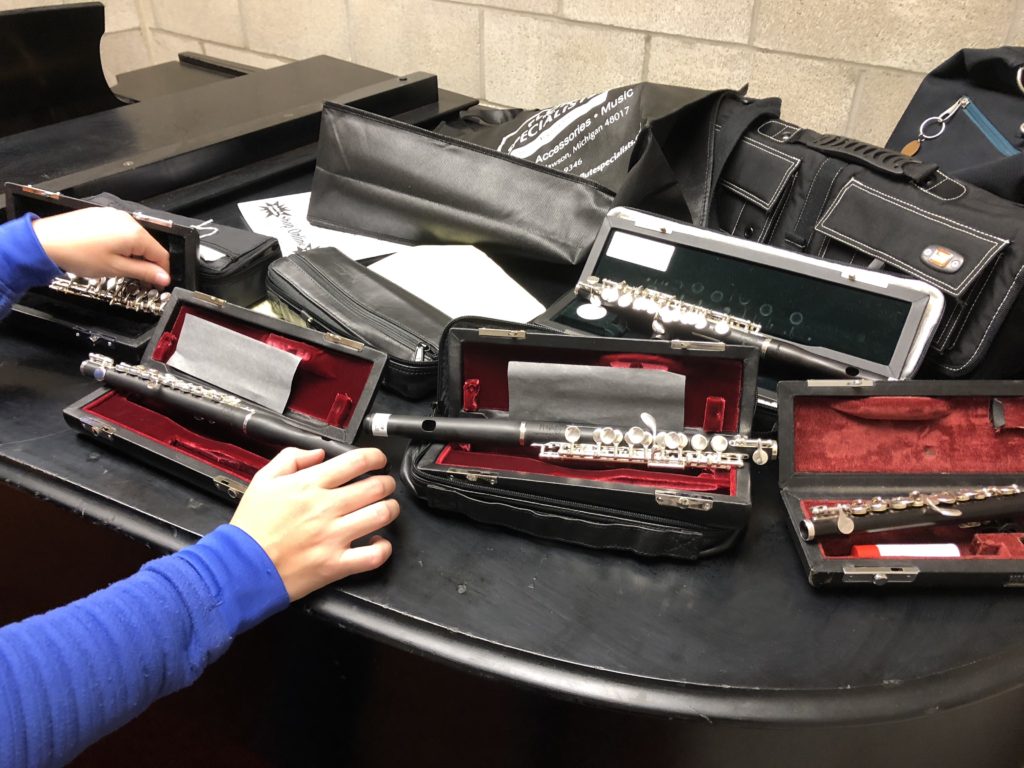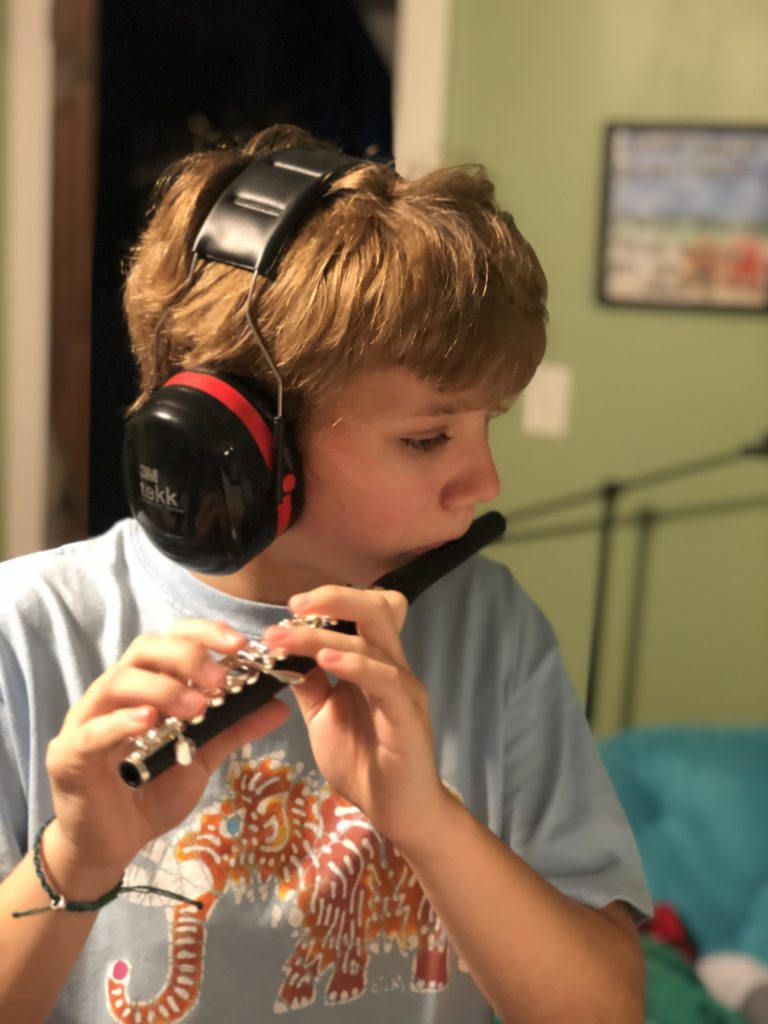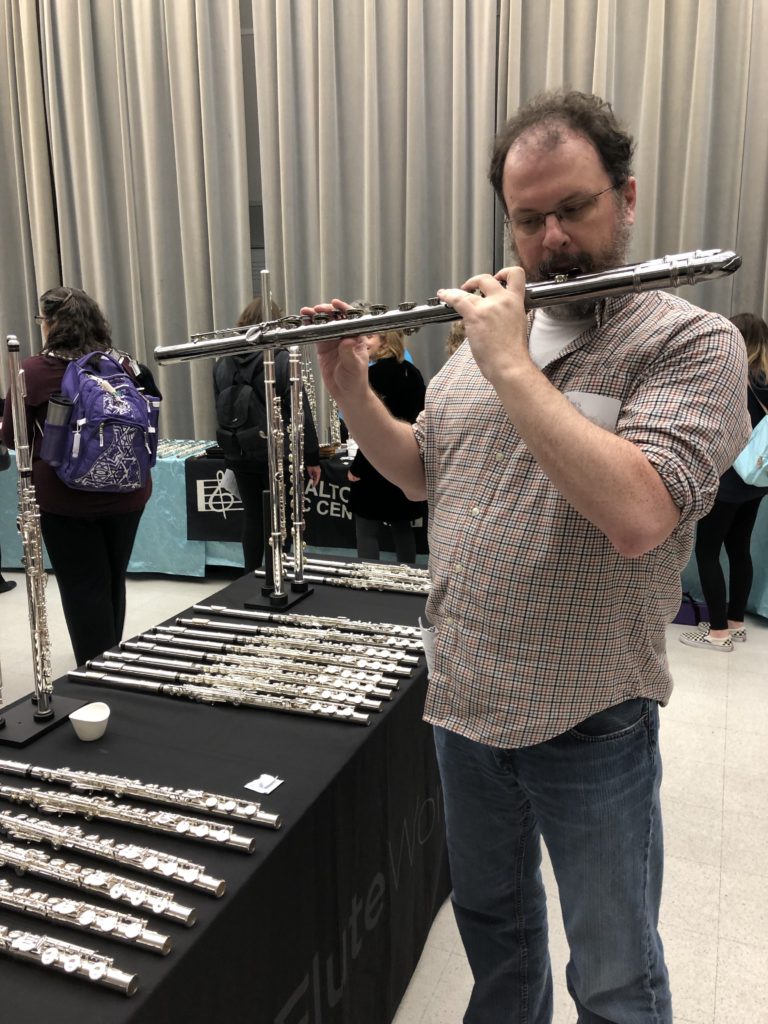5 Tests for Shopping for the Best Flute for You

Shopping for a new instrument can be a lot of fun! In two previous blog articles (“New Flute Buying Guide” and “Intermediate Flute Buying Guide”), I discussed the different types of flutes, features, and specifications. Today I will talk about ways to test a flute: what to listen for and how to narrow the field.
My daughter needed a new piccolo. We went to the Central Ohio Flute Association’s Flute Festival. Together, we used this method to chose the best piccolo for her.

Find a Quiet Place. Choose 4-7 Flutes to Test
Once you have narrowed your choices to the flutes that serve your needs and fit into your price range, you are ready to begin testing. Many music stores will allow you to use a practice room or quiet back room for play testing. Online retailers will ship several flutes for you to try at home.
Tone
Play some long tones. What is your first impression? Almost always we have a visceral reaction to the first tones on the flute. If your first feeling is “yuck,” put the flute down. No further testing is necessary.
If you like the tone or if it sparks curiosity, continue with the next tests. Play some slow scales or a legato passage you know from memory.
Develop a vocabulary for describing the tone. Does it sound “silky,” “bold,” “fluid,” “nasal,” “bright?” Perhaps you can assign a color to the tone. Be specific. Instead of purple, you might think “indigo velvet, like the kind a queen would wear in the winter.”
Begin playing the flutes one after another. It’s helpful if you can have a friend help you by handing you the flutes. Try playing without looking to see which is which. Playing the same short passage on each flute is helpful.
Response
Does the flute feel easy to play, free, and air efficient? Or do you have to blow more air while feeling more resistance? A more resistant flute could be the right flute for you, so don’t discount it. Just notice.
Play short detached notes in all octaves. Listen for the beginning sound. Is it crisp and controlled or jagged? How easy is it to hit the high notes? Try the combination A-E in the upper octave. Does the sound split or is it easy to go between the notes?
Do some passages that include double tonguing. What is the response of the flute? How fast can you go and keep the notes clear?
Intonation
Play scales with a tuner. Are the registers consistently sharp or flat? Try our famously out of tune notes:
- C# in the staff (tendency is sharp)
- low C, D-flat, and D (tendency is flat)
- high E-flat (tendency is sharp)
Dynamic Range
Play loud low notes, high notes with tapers. Use a tuner and see how much you have to adjust to keep the notes in tune.
In the middle range, how much air can you blow before the note breaks?
Get Help
Enlist the help of a friend to help you do a blind test of your short-listed flutes. Your friend should hand you the flutes. Don’t look at the flute or try to guess which one it is. I suggest adding your current flute to the test flutes. I find it helpful to have a “control” flute in the mix. Try playing the same passage on all the flutes. Which one is your favorite?
Now play the flutes for your friend but don’t let your friend know which one you are playing. Play the same test passage. Which one is your friend’s favorite?
If your favorite and your friend’s favorite are the same flute, you have found your new instrument! Your shopping expedition is complete.

Ask Questions
Once you have found the right instrument, find out if there’s a warranty. I know that Flute World gives you 90 days to have the flute adjusted for free by their technicians. Some places will allow you to finance the instrument, spreading out payments over several year. Ask questions before you swipe a card and officially end the shopping expedition.
Have Fun
Even if you’re not ready to buy a new instrument, it can be fun to try things anyway. This helps you to develop a vocabulary and a feel for what you like best. The picture below is my adult student trying a bass flute, just for fun!

Leave a Reply Cancel reply
You must be logged in to post a comment.
BLOG
- One Grown and Flown September 5, 2023
- Online Music Lessons: One Year And Counting March 25, 2021
- Breathing for Flutists, According to Arnold Jacobs October 31, 2020
- Music Video Projects: Music in the Time of COVID September 30, 2020
- Flutes in Quarantine: Pandemic Safety Part 2 August 31, 2020
- Pandemic Flute Safety, Part 1 July 31, 2020
- Virtual Music: Teaching Lessons Online: The Difficult June 25, 2020
- Virtual Music: Teaching Lessons Online: The Good May 31, 2020
Announcements
FACEBOOK "Like" Miss Marlene- Dance and Sing to get the scoop on preschool music including classes, concerts, and special events. Miss Marlene- Dance and Sing
FLUTE STUDIO
Lesson times are available on Mondays, Tuesday, and Wednesdays. I teach flute and recorder (soprano, alto, tenor, bass) to students of all ages and levels. Prospective students should contact me about a free trial lesson.
Archives
- September 2023
- March 2021
- October 2020
- September 2020
- August 2020
- July 2020
- June 2020
- May 2020
- April 2020
- March 2020
- February 2020
- January 2020
- December 2019
- November 2019
- October 2019
- September 2019
- August 2019
- July 2019
- June 2019
- May 2019
- April 2019
- March 2019
- February 2019
- January 2019
- December 2018
- November 2018
- October 2018
- September 2018
- August 2018
- July 2018
- June 2018
- May 2018
- April 2018
- March 2018
- February 2018
- January 2018
- December 2017
- November 2017
- October 2017
- September 2017
- August 2017
- July 2017
- June 2017
- May 2017
- April 2017
- March 2017
- February 2017
- January 2017
- December 2016
- November 2016
- October 2016
- September 2016
- August 2016
- July 2016
- June 2016
- May 2016
- April 2016
- March 2016
- February 2016
- January 2016
- December 2015
- November 2015
- October 2015
- September 2015
- August 2015
- July 2015
- June 2015
- May 2015
- April 2015
- March 2015
- February 2015
No comments.